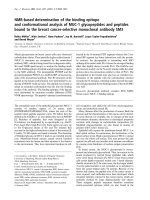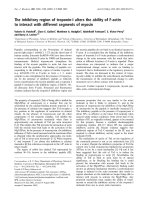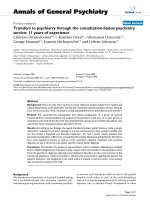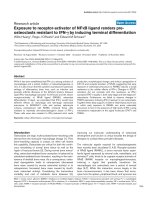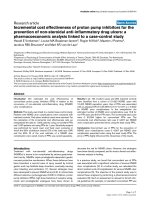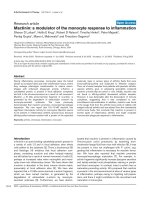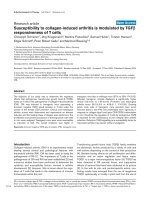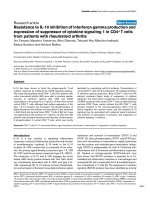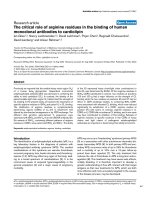Báo cáo y học: "Response to: Comparison of laser Doppler imaging, fingertip lacticemy test, and nailfold capillaroscopy for assessment of digital microcirculation in systemic sclerosis" potx
Bạn đang xem bản rút gọn của tài liệu. Xem và tải ngay bản đầy đủ của tài liệu tại đây (122.51 KB, 2 trang )
We read with interest the article by Correa and colleagues
[1] in a recent issue of Arthritis Research & erapy:
‘Compari son of laser Doppler imaging, fi ngertip lacti-
cemy test, and nailfold capillaroscopy for assessment of
digital microcirculation in systemic sclerosis’.
Using the laser Doppler imaging (LDI) technique, the
authors found lower digital blood fl ow in systemic
sclerosis (SSc) patients when compared with healthy
controls. However, the authors did not discover any
correlation between the functional (LDI) and morpho-
logical micro vascular abnormalities, evaluated by nailfold
capillaro scopy (NFC), suggesting that these techniques
are complementary tools for the evaluation of indepen-
dent microangiopathy aspects in SSc patients.
e conclusions of the article may be controversial
since these fi ndings are in contrast with those of other
recent reports that were not reported and considered in
the authors’ investigation. In particular, some recent
studies described a correlation between fi ngertip blood
perfusion (FBP), evaluated separately by LDI and laser
Doppler fl owmetry (LDF) techniques, and the extent of
nailfold microvascular damage, as evaluated by nailfold
videocapillaroscopy (NVC) [2-4].
e paper from Cutolo and colleagues [2] demonstrated
a signifi cantly lower FBP in SSc patients (P <0.05) com-
pared with controls, and this FBP was found to be
partially reversible (increasing) after heating of the LDF
probe at 36°C (P <0.001), even if the slope of variation
was signifi cantly lower in SSc patients com pared with
controls (P <0.05). Interestingly, SSc patients showing the
‘late’ NVC pattern of micro angiopathy showed an FBP
that was signifi cantly lower than that of patients with the
‘active’ or ‘early’ NVC patterns (P <0.05) [2,5]. In addition,
a nega tive correlation between the FBP degree and the
NVC rating (score) of the microvascular damage was
observed (P <0.05) [2,6,7].
Similar results were found by Rosato and colleagues [3],
who described signifi cantly lower mean blood perfusion
in the hand/fi ngers of SSc patients characterized by the
‘late’ NVC pattern of microangiopathy when compared
with patients showing the ‘early’ or ‘active’ NVC patterns.
e authors concluded that the LDI and capillaroscopic
images fully matched the defi nition of the various stages
of the microvascular digital damage in SSc [3].
In the third study, again, SSc patients characterized by
the ‘active’ or ‘late’ NVC patterns showed a red blood cell
velocity that was more decreased (65.5% and 66.2%
reduction, respectively) than that of patients sharing the
‘early’ pattern of micro angio pathy [4]. is reduced red
blood cell velocity was signifi cantly associated with
selected NVC morphological parameters, including
capil lary ramifi cation and capillary loss that characterize
the advanced microvascular damage (P <0.01) [4].
In recent years, the morphological features identifying
the SSc microvascular damage progression have been
recog nized. Consequently, microvascular lesions detected
by NVC in patients with SSc have been classifi ed accord-
ing to the three diff erent NVC patterns mentioned above
(namely, ‘early’, ‘active’, and ‘late’), which are clearly
distinguishable from the ‘normal’ nailfold capillaroscopic
pattern [5,8].
e ‘early’ pattern is characterized by the presence of a
small number of giant capillaries and capillary micro-
hemorrhages, no evident loss of capillaries, and relatively
well-preserved capillary distribution. If the vascular
disease progresses, an ‘active’ SSc pattern becomes
evident: giant capillaries and capillary microhemorrhages
© 2010 BioMed Central Ltd
Response to: Comparison of laser Doppler imaging,
ngertip lacticemy test, and nailfold capillaroscopy
for assessment of digital microcirculation in
systemic sclerosis
Alberto Sulli
1
, Vanessa Smith
2
and Maurizio Cutolo*
1
See related research by Correa et al., and related letter by Correa et al.,
/>LETTER
*Correspondence:
1
Research Laboratory and Academic Unit of Clinical Rheumatology, Department of
Internal Medicine, University of Genova, Viale Benedetto XV, 6, 16132 Genova, Italy
Full list of author information is available at the end of the article
Sulli et al. Arthritis Research & Therapy 2011, 13:301
/>© 2011 BioMed Central Ltd
increase and there is moderate loss of capillary, whereas
ramifi ed capillaries are absent or mildly branched and the
capillary architecture is mildly disorganized. Finally, the
‘late’ SSc pattern becomes manifest in the more advanced
stage of the vascular disease. is latter pattern is
characterized by the absence of giant capillaries and
microhemorrhages but shares severe loss of capillaries
and the development of extensive avascular areas,
together with ramifi ed and bushy capillaries (indicative of
neoangiogenesis) [5,8]. As a matter of fact, the diff erent
nailfold microvascular abnormalities are not all present
at the same time but are expressed in a dynamic manner
during the progression of the SSc microangiopathy [9].
For these reasons, when searching in SSc patients for a
possible link between digital blood fl ow and nailfold
capillary abnormalities without considering the dynamic
evolution of these morphological markers, a lack of
correlation may be expected. Obviously, further studies
are needed to better understand whether the morpho-
logical nailfold capillary abnormalities are the cause or
the eff ect (or both) of digital blood hypoperfusion in
patients with SSc.
Abbreviations
FBP, ngertip blood perfusion; LDF, laser Doppler owmetry; LDI, laser Doppler
imaging; NFC, nailfold capillaroscopy; NVC, nailfold videocapillaroscopy; SSc,
systemic sclerosis.
Competing interests
The authors declare that they have no competing interests.
Author details
1
Research Laboratory and Academic Unit of Clinical Rheumatology,
Department of Internal Medicine, University of Genova, Viale Benedetto XV,
6, 16132 Genova, Italy;
2
Department of Rheumatology, Ghent University
Hospital,De Pintelaan 185, 9000 Gent, Belgium.
Published: 24 January 2011
References
1. Correa MJ, Andrade LE, Kayser C: Comparison of laser Doppler imaging,
ngertip lacticemy test, and nailfold capillaroscopy for assessment of
digital microcirculation in systemic sclerosis. Arthritis Res Ther 2010, 12:R157.
2. Cutolo M, Ferrone C, Pizzorni C, Soldano S, Seriolo B, Sulli A: Peripheral blood
perfusion correlates with microvascular abnormalities in systemic
sclerosis: a laser-Doppler and nailfold videocapillaroscopy study.
JRheumatol 2010, 37:1174-1180.
3. Rosato E, Borghese F, Pisarri S, Salsano F: Laser Doppler perfusion imaging is
useful in the study of Raynaud’s phenomenon and improves the
capillaroscopic diagnosis. J Rheumatol 2009, 36:2257-2263.
4. Mugii N, Hasegawa M, Hamaguchi Y, Tanaka C, Kaji K, Komura K,
Ueda-Hayakawa I, Horie S, Ikuta M, Tachino K, Ogawa F, Sato S, Fujimoto M,
Takehara K: Reduced red blood cell velocity in nail-fold capillaries as a
sensitive and speci c indicator of microcirculation injury in systemic
sclerosis. Rheumatology (Oxford) 2009, 48:696-703.
5. Cutolo M, Pizzorni C, Tuccio M, Burroni A, Craviotto C, Basso M, Seriolo B, Sulli
A: Nailfold videocapillaroscopic patterns and serum autoantibodies in
systemic sclerosis. Rheumatology 2004, 43:719-726.
6. Sulli A, Secchi ME, Pizzorni C, Cutolo M: Scoring the nailfold microvascular
changes during the capillaroscopic analysis in systemic sclerosis patients.
Ann Rheum Dis 2008, 67:885-887.
7. Smith V, Pizzorni C, De Keyser F, Decuman S, Van Praet JT, Deschepper E, Sulli
A, Cutolo M: Reliability of the qualitative and semiquantitative nailfold
videocapillaroscopy assessment in a systemic sclerosis cohort:
atwo-centre study. Ann Rheum Dis 2010, 69:1092-1096.
8. Cutolo M, Sulli A, Smith V: Assessing microvascular changes in systemic
sclerosis diagnosis and management. Nat Rev Rheumatol 2010, 6:578-587.
9. Herrick AL, Cutolo M: Clinical implications from capillaroscopic analysis in
patients with Raynaud’s phenomenon and systemic sclerosis. Arthritis
Rheum 2010, 62:2595-2604.
doi:10.1186/ar3201
Cite this article as: Sulli A, et al.: Response to: Comparison of laser
Doppler imaging, ngertip lacticemy test, and nailfold capillaroscopy for
assessment of digital microcirculation in systemic sclerosis. Arthritis Research
& Therapy 2011, 13:301.
Sulli et al. Arthritis Research & Therapy 2011, 13:301
/>Page 2 of 2
